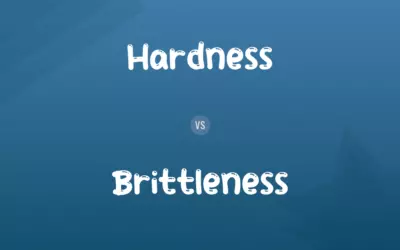Walking Stick vs. Walking Cane: Difference and Comparison
By Muazma Batool & Muneeza Rehman — Published on March 30, 2024
A walking stick is primarily used for balance and support during hiking or walking on uneven terrain, often taller and straight. A walking cane is designed to assist with mobility and stability for everyday use.

Difference Between Walking Stick and Walking Cane
Walking sticks, also known as hiking sticks or trekking poles, are designed for outdoor activities. They provide balance on rugged terrains, help distribute weight more evenly, and can reduce stress on the legs and knees. Walking canes, on the other hand, are mobility aids for individuals who require additional support due to injury, disability, or age. Canes help users maintain their balance, transfer weight from the legs to the upper body, and signal a physical condition that requires special consideration.
Muazma Batool
Mar 30, 2024
Walking sticks are versatile, often made from wood or lightweight metals, and some are adjustable in height or foldable for convenience. They are usually held in front of the body and can be used in pairs. Walking canes, come in various materials, including wood, metal, and plastic, and feature different handle types, such as the crook, T-handle, or ergonomic designs, for comfort and ease of use. Canes are typically used on the side opposite of the weaker or injured leg.
Muazma Batool
Mar 30, 2024
The choice between a walking stick and a walking cane depends on the user's needs. For outdoor enthusiasts who need support while hiking, a walking stick is suitable. For those needing daily support for walking or standing, a walking cane is the better option. Both aids serve to enhance mobility but cater to different requirements and settings.
Muazma Batool
Mar 30, 2024
Walking Stick vs. Walking Cane Comparison Chart
Primary Use
Balance and support on uneven terrain
Mobility and stability for everyday use
Muazma Batool
Mar 30, 2024
Design
Taller, often straight, may be adjustable
Shorter, with a curved or specialized handle
Muazma Batool
Mar 30, 2024
Material
Wood, lightweight metals, carbon fiber
Wood, metal, plastic, composite materials
Muazma Batool
Mar 30, 2024
Used In
Outdoor activities, hiking
Daily activities, particularly by those with mobility issues
Muazma Batool
Mar 30, 2024
Support
Helps with balance and weight distribution
Assists with balance, weight support, and signaling a physical condition
Muazma Batool
Mar 30, 2024
Height
Taller, reaching up to the user's wrist or higher when the arm is extended
Typically comes up to the hip joint for proper support
Muazma Batool
Mar 30, 2024
Users
Hikers, outdoor enthusiasts
Individuals with injuries, disabilities, age-related mobility issues
Muazma Batool
Mar 30, 2024
Walking Stick vs. Walking Cane Definitions
◉Walking Stick
Often taller and straight for navigating terrain.
His walking stick was a sturdy companion on uneven paths.
Muazma Batool
Feb 27, 2024
◉Walking Cane
Made from various materials for durability and style.
His elegant wooden cane was both a functional aid and a fashion statement.
Muazma Batool
Feb 27, 2024
◉Walking Stick
Used for weight distribution during hikes.
Using a walking stick helped reduce the stress on his knees.
Elijah
Feb 27, 2024
◉Walking Cane
A mobility aid for daily use, offering stability.
After his surgery, he relied on a walking cane for extra support.
Muazma Batool
Feb 27, 2024
◉Walking Stick
Enhances outdoor mobility and enjoyment.
Their walking sticks were essential for the long day of exploring.
Levi
Feb 27, 2024
◉Walking Cane
Features a curved handle for an easy grip.
Her walking cane had an ergonomic handle that was comfortable to hold.
Muazma Batool
Feb 27, 2024
◉Walking Stick
Can be adjustable or foldable for convenience.
Her adjustable walking stick fit perfectly in her backpack for travel.
Muazma Batool
Feb 27, 2024
◉Walking Cane
Used opposite the weaker leg for support.
She used the cane on her right side to support her left leg.
Muazma Batool
Feb 27, 2024
◉Walking Stick
An aid for outdoor walking, providing balance.
She used a walking stick to navigate the steep mountain trail.
Muazma Batool
Feb 27, 2024
◉Walking Cane
Signifies a physical condition requiring care.
The presence of a cane signaled his need for a bit more patience and assistance.
Leo
Feb 27, 2024
Walking Stick vs. Walking Cane Frequently Asked Questions
Is it possible to have a walking aid that is both a cane and a stick?
There are hybrid models designed to offer the portability and height of a walking stick with the support features of a cane, catering to users who need versatility.
Muazma Batool
Mar 30, 2024
Can canes have specialized features?
Yes, canes can include features like adjustable heights, foldability, seats, and even built-in lights for added functionality and safety.
Jonathan
Mar 30, 2024
Can a walking stick be used as a cane?
While a walking stick can provide temporary support on flat surfaces, it's not designed for the same level of support or daily use as a cane, particularly for those with significant mobility issues.
Muazma Batool
Mar 30, 2024
How do I choose the right height for a cane or walking stick?
For a cane, the top should reach the crease of your wrist when your arm is at your side. For a walking stick, it should be comfortable to hold when your arm is slightly bent, usually coming up to or just above the wrist when your arm is extended.
Muazma Batool
Mar 30, 2024
Are there walking sticks suitable for urban use?
While traditionally designed for outdoor use, some walking sticks are styled and marketed for urban walkers who prefer their height and style over traditional canes.
Muazma Batool
Mar 30, 2024
How important is the material of a walking cane or stick?
The material impacts the weight, durability, and appearance of the aid. Your choice should balance personal aesthetics with functional needs, considering factors like strength, weight, and grip comfort.
Muazma Batool
Mar 30, 2024
Should I use my walking cane or stick on a specific side?
A cane should be used on the side opposite the injury or weaker leg to provide proper support. Walking sticks are more flexible but using them on the dominant side can offer better balance and control.
Muazma Batool
Mar 30, 2024
How do I maintain my walking cane or stick?
Regularly check for wear, especially on the tip and handle. Wooden items may require occasional polishing, and metal or composite materials should be cleaned and checked for damage to ensure safety and longevity.
Muazma Batool
Mar 30, 2024
Can walking sticks and canes help with knee pain?
Yes, both can help alleviate knee pain by redistributing weight and reducing pressure on the knees, though a cane is specifically designed for more continuous support in daily activities.
Muazma Batool
Mar 30, 2024
Are there walking canes designed for both left and right-handed users?
Yes, there are canes specifically designed for left or right-handed use, particularly those with ergonomic handles. However, many canes are designed to be used with either hand.
Muazma Batool
Mar 30, 2024
Content Creators
Written by
Muazma BatoolAs a content editor, Muazma Batool is not just a grammar guru but a creative mastermind who breathes life into every word. With an eagle eye for detail and a passion for storytelling, she transforms bland text into engaging content that captivates audiences and drives results.
Co-written by
Muneeza RehmanAt Comparisons.wiki, Muneeza skillfully navigates the vast sea of information, ensuring clarity and accuracy as the lead content editor. With a keen eye for detail, she curates every comparison to enlighten and engage readers.






























